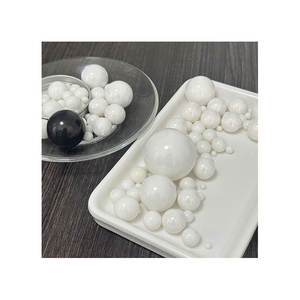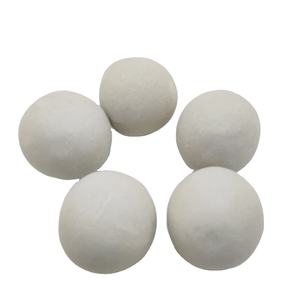1. Material Principles and Microstructural Characteristics
1.1 Structure and Crystallographic Characteristic of Al Two O TWO
(Alumina Ceramic Balls´╝î Alumina Ceramic Balls)
Alumina ceramic balls are spherical components produced from light weight aluminum oxide (Al two O THREE), a fully oxidized, polycrystalline ceramic that exhibits remarkable hardness, chemical inertness, and thermal security.
The key crystalline stage in high-performance alumina rounds is ╬▒-alumina, which embraces a corundum-type hexagonal close-packed structure where aluminum ions inhabit two-thirds of the octahedral interstices within an oxygen anion lattice, giving high latticework energy and resistance to stage improvement.
Industrial-grade alumina rounds normally include 85% to 99.9% Al Two O TWO, with purity directly affecting mechanical strength, wear resistance, and deterioration efficiency.
High-purity grades (Ôëą 95% Al Two O SIX) are sintered to near-theoretical thickness (> 99%) utilizing sophisticated strategies such as pressureless sintering or hot isostatic pressing, minimizing porosity and intergranular flaws that might work as stress and anxiety concentrators.
The resulting microstructure contains fine, equiaxed grains consistently distributed throughout the quantity, with grain sizes commonly ranging from 1 to 5 micrometers, enhanced to stabilize sturdiness and solidity.
1.2 Mechanical and Physical Residential Or Commercial Property Profile
Alumina ceramic rounds are renowned for their severe solidity– measured at around 1800– 2000 HV on the Vickers range– surpassing most steels and equaling tungsten carbide, making them ideal for wear-intensive atmospheres.
Their high compressive strength (approximately 2500 MPa) makes certain dimensional stability under lots, while reduced elastic contortion enhances accuracy in rolling and grinding applications.
In spite of their brittleness about metals, alumina balls display excellent crack durability for porcelains, particularly when grain growth is regulated during sintering.
They keep structural stability throughout a broad temperature range, from cryogenic problems as much as 1600 ┬░ C in oxidizing environments, much going beyond the thermal limitations of polymer or steel equivalents.
Furthermore, their low thermal expansion coefficient (~ 8 ├Ś 10 Ôü╗ÔüÂ/ K) minimizes thermal shock susceptibility, enabling usage in quickly fluctuating thermal settings such as kilns and warmth exchangers.
2. Manufacturing Processes and Quality Control
()
2.1 Shaping and Sintering Techniques
The manufacturing of alumina ceramic balls starts with high-purity alumina powder, often stemmed from calcined bauxite or chemically precipitated hydrates, which is crushed to achieve submicron bit dimension and narrow dimension circulation.
Powders are after that created right into round environment-friendly bodies using techniques such as extrusion-spheronization, spray drying out, or ball creating in revolving frying pans, relying on the wanted size and set range.
After forming, green rounds undergo a binder burnout phase complied with by high-temperature sintering, usually between 1500 ┬░ C and 1700 ┬░ C, where diffusion systems drive densification and grain coarsening.
Accurate control of sintering atmosphere (air or regulated oxygen partial pressure), home heating rate, and dwell time is essential to accomplishing uniform shrinkage, round geometry, and marginal inner flaws.
For ultra-high-performance applications, post-sintering treatments such as hot isostatic pressing (HIP) may be related to remove residual microporosity and additionally enhance mechanical integrity.
2.2 Precision Finishing and Metrological Confirmation
Following sintering, alumina spheres are ground and brightened using diamond-impregnated media to attain limited dimensional tolerances and surface area finishes comparable to bearing-grade steel spheres.
Surface area roughness is normally lowered to less than 0.05 ╬╝m Ra, lessening rubbing and use in dynamic call circumstances.
Important high quality criteria consist of sphericity (deviation from best satiation), diameter variation, surface area integrity, and thickness harmony, every one of which are gauged using optical interferometry, coordinate determining equipments (CMM), and laser profilometry.
International criteria such as ISO 3290 and ANSI/ABMA specify tolerance grades for ceramic balls used in bearings, guaranteeing interchangeability and performance uniformity throughout suppliers.
Non-destructive screening techniques like ultrasonic evaluation or X-ray microtomography are utilized to spot interior fractures, gaps, or inclusions that can compromise lasting dependability.
3. Practical Advantages Over Metal and Polymer Counterparts
3.1 Chemical and Rust Resistance in Harsh Environments
One of the most significant advantages of alumina ceramic balls is their superior resistance to chemical strike.
They stay inert in the presence of strong acids (other than hydrofluoric acid), antacid, natural solvents, and saline remedies, making them suitable for usage in chemical handling, pharmaceutical production, and aquatic applications where metal elements would certainly wear away swiftly.
This inertness prevents contamination of sensitive media, a vital factor in food processing, semiconductor fabrication, and biomedical equipment.
Unlike steel rounds, alumina does not produce corrosion or metal ions, ensuring process purity and minimizing upkeep regularity.
Their non-magnetic nature additionally expands applicability to MRI-compatible devices and electronic production line where magnetic disturbance should be stayed clear of.
3.2 Put On Resistance and Long Service Life
In rough or high-cycle settings, alumina ceramic spheres display wear rates orders of size lower than steel or polymer options.
This remarkable sturdiness translates right into prolonged solution intervals, reduced downtime, and reduced total price of ownership regardless of higher first procurement costs.
They are extensively made use of as grinding media in round mills for pigment dispersion, mineral handling, and nanomaterial synthesis, where their inertness prevents contamination and their hardness makes certain efficient bit size reduction.
In mechanical seals and valve components, alumina rounds preserve limited tolerances over countless cycles, resisting erosion from particulate-laden liquids.
4. Industrial and Arising Applications
4.1 Bearings, Shutoffs, and Liquid Handling Systems
Alumina ceramic spheres are integral to hybrid sphere bearings, where they are coupled with steel or silicon nitride races to integrate the low thickness and corrosion resistance of ceramics with the strength of steels.
Their reduced thickness (~ 3.9 g/cm FOUR, regarding 40% lighter than steel) minimizes centrifugal filling at high rotational speeds, making it possible for quicker procedure with reduced warm generation and enhanced energy performance.
Such bearings are made use of in high-speed spindles, oral handpieces, and aerospace systems where reliability under severe problems is critical.
In liquid control applications, alumina balls act as check valve components in pumps and metering tools, especially for hostile chemicals, high-purity water, or ultra-high vacuum systems.
Their smooth surface and dimensional stability guarantee repeatable sealing performance and resistance to galling or taking.
4.2 Biomedical, Power, and Advanced Innovation Uses
Past typical commercial functions, alumina ceramic rounds are locating use in biomedical implants and analysis devices because of their biocompatibility and radiolucency.
They are employed in artificial joints and oral prosthetics where wear debris must be lessened to stop inflammatory responses.
In power systems, they function as inert tracers in tank characterization or as heat-stable components in concentrated solar energy and gas cell settings up.
Research is likewise discovering functionalized alumina spheres for catalytic assistance, sensing unit components, and accuracy calibration standards in metrology.
In recap, alumina ceramic spheres exemplify just how advanced porcelains connect the space in between architectural toughness and practical precision.
Their unique mix of solidity, chemical inertness, thermal security, and dimensional precision makes them crucial sought after design systems across varied fields.
As manufacturing strategies continue to boost, their efficiency and application extent are expected to increase even more right into next-generation technologies.
5. Provider
Advanced Ceramics founded on October 17, 2012, is a high-tech enterprise committed to the research and development, production, processing, sales and technical services of ceramic relative materials such as Alumina Ceramic Balls. Our products includes but not limited to Boron Carbide Ceramic Products, Boron Nitride Ceramic Products, Silicon Carbide Ceramic Products, Silicon Nitride Ceramic Products, Zirconium Dioxide Ceramic Products, etc. If you are interested, please feel free to contact us.(nanotrun@yahoo.com)
Tags: alumina balls,alumina balls,alumina ceramic balls
All articles and pictures are from the Internet. If there are any copyright issues, please contact us in time to delete.
Inquiry us

